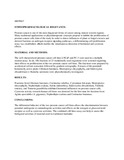| dc.contributor.author | Bobach, C | |
| dc.contributor.author | Schurwanz, J | |
| dc.contributor.author | Franke, K | |
| dc.contributor.author | Denkert, A | |
| dc.contributor.author | Sung, TV | |
| dc.contributor.author | Kuster, R | |
| dc.contributor.author | Mutiso, PC | |
| dc.contributor.author | Seliger, B | |
| dc.contributor.author | Wessjohann, LA | |
| dc.date.accessioned | 2014-06-26T11:50:08Z | |
| dc.date.available | 2014-06-26T11:50:08Z | |
| dc.date.issued | 2014 | |
| dc.identifier.citation | Bobach, C., Schurwanz, J., Franke, K., Denkert, A., Sung, T. V., Kuster, R., ... & Wessjohann, L. A. (2014). Multiple readout assay for hormonal (androgenic and antiandrogenic) and cytotoxic activity of plant and fungal extracts based on differential prostate cancer cell line behavior. Journal of Ethnopharmacology. | en_US |
| dc.identifier.uri | http://www.ncbi.nlm.nih.gov/pubmed/24945396 | |
| dc.identifier.uri | http://hdl.handle.net/11295/71161 | |
| dc.description.abstract | ETHNOPHARMACOLOGICAL RELEVANCE:
Prostate cancer is one of the most diagnosed forms of cancer among men in western regions. Many traditional applications or phytotherapeutic concepts propose to inhibit the proliferation of prostate cancer cells.Aim of the study In order to detect influences of plant or fungal extracts and derived fractions on androgen receptor signaling pathways, a differentiating cell proliferation assay was established, which enables the simultaneous detection of hormonal and cytotoxic effects.
MATERIAL AND METHODS:
The well characterized prostate cancer cell lines LNCaP and PC-3 were used in a multiple readout assay. In all, 186 fractions of 23 traditionally used organisms were screened regarding their effects on proliferation of the two prostate cancer cell lines. The fractions were prepared by accelerated solvent extraction followed by gradient extrography. Extracts of the potential hormonally active plants Cibotium barometz, Heteropterys chrysophylla, and Sideroxylon obtusifolium (= Bumelia sartorum) were phytochemically investigated.
RESULTS:
Fractions from Cibotium barometz, Cortinarius rubellus, Cyrtomium falcatum, Heteropterys chrysophylla, Nephrolepis exaltata, Salvia miltiorrhiza, Sideroxylon obtusifolium, Trichilia emetica, and Trimeria grandifolia exhibited hormonal influences on prostate cancer cells. Cytotoxic activity towards human cell lines was detected for the first time for fractions from Aglaia spectabilis (A. gigantea), Nephrolepis exaltata and Cortinarius brunneus.
CONCLUSIONS:
The differential behavior of the two prostate cancer cell lines allows the discrimination between potential androgenic or antiandrogenic activities and effects on the estrogen or glucocorticoid receptor as well as cytotoxic activities. The combined cell lines assay can help to assess the biological activities of material used in traditional medicine.
Copyright © 2014. Published by Elsevier Ireland Ltd. | en_US |
| dc.language.iso | en | en_US |
| dc.publisher | University of Nairobi, | en_US |
| dc.title | Multiple readout assay for hormonal (androgenic and antiandrogenic) and cytotoxic activity of plant and fungal extracts based on differential prostate cancer cell line behavior. | en_US |
| dc.type | Article | en_US |

